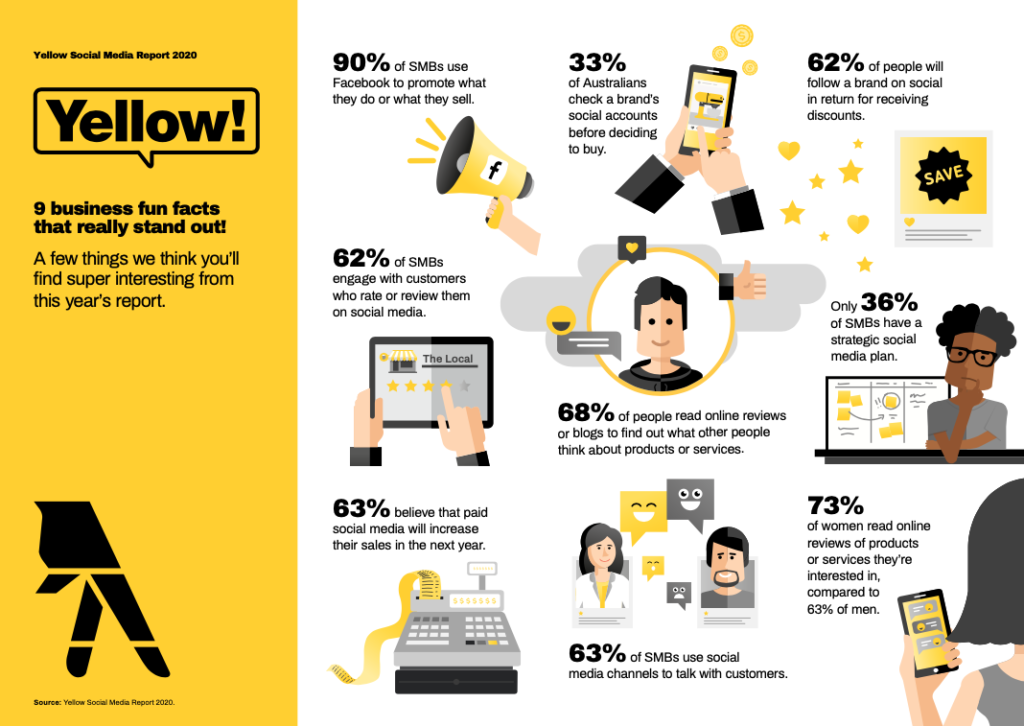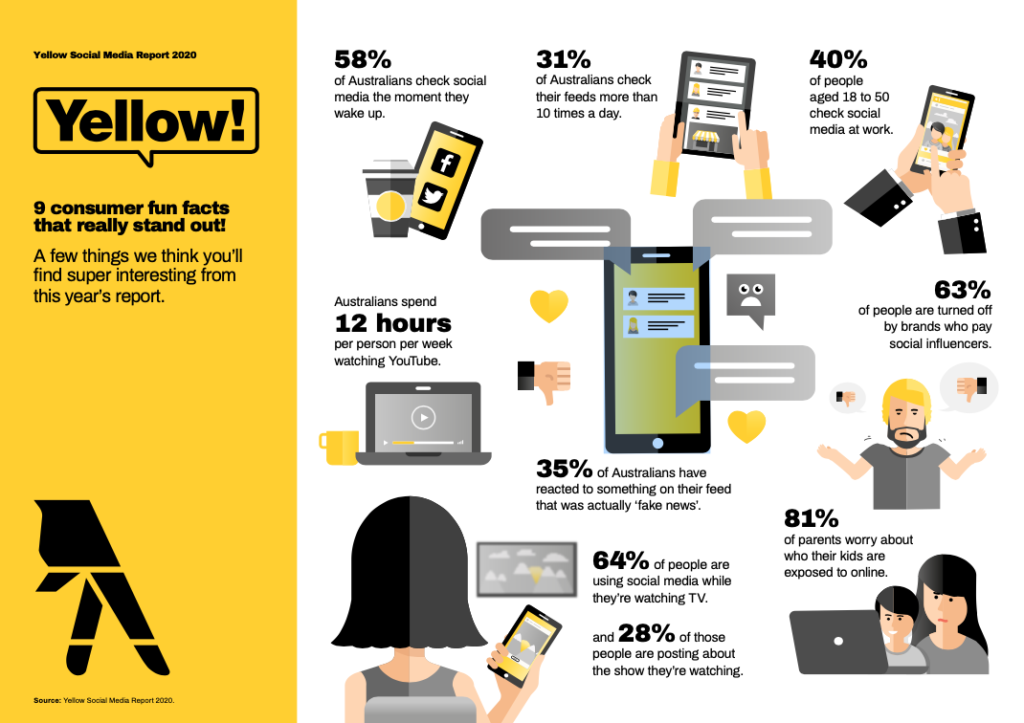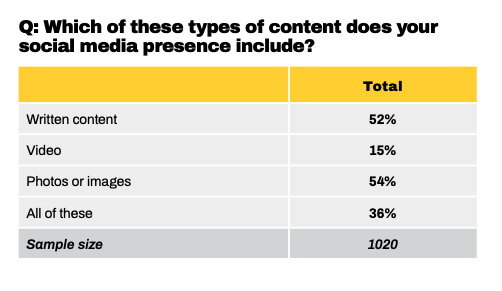The Yellow report into Australians’ social media habits is now out, and it provides some serious food for thought for businesses that aren’t yet taking social seriously.
Firstly, let’s look at some areas of consumer behaviour when it comes to social media, and what this means for brands.
33% of Australians check a brand’s social accounts before deciding to buy.
Righto. People are checking out your socials – one-third of us to be exact.
What will they find? Will it do justice to your brand? Will the content and the comments on your Facebook Page, Instagram or Twitter account fill them with sufficient confidence that they’ll want to do business with you?
Or will what they find on your social channels put them off your brand forever?
68% of people read online reviews or blogs to find out what other people think about products or services.
This one’s a little out of the control of businesses in as much as they can’t delete comments or other people’s blogs that diss their brand. But businesses can control how well they serve their customers, including handling consumer complaints.

But over and above making sure your product or service is top-notch (table stakes today) and that the consumer experience is a good one, there is something else businesses can do: proactively deepen the level of connection they have with customers and clients.
Does your business deliver value over and above its products and services through the provision of useful and helpful content?
Does it run events that educate or inspire consumers?
Does it support issues and causes dear to the hearts of your customers?
Such activities – done well, with passion, purpose and strategic intent – will help build people’s trust in, and affinity for, your brand. In turn, this has the potential to inspire your customers to write nice things about your business on social media and review sites.
48% of social media users take no notice of ads on social media, and 53 per cent ignore sponsored posts from businesses they don’t follow.

If your business is ‘putting all its eggs’ into the paid social basket at the expense of building a community of engaged consumers who like and trust your brand, then there’s every chance this exercise is going to become not only more difficult over time, but also expensive.
Personally, I think it’s critical for brands to organically build visibility and respect with your audience over and over again through ongoing value-added communications.
This means that when you do advertise, those people who have been exposed to your brand not only might take notice of you, they may even like and trust your brand because of the connection you’ve nurtured over time.
The result, therefore, is an audience that might be more predisposed to your sales message. In other words, warm up your audience before you start pitching your wares on social media, versus simply advertising to them cold.
Only 36% of SMBs have a strategic social media plan.
With social media, it’s really easy just to do stuff! And let’s face it, social media can be an insatiable beast that needs constant feeding; this in turn heightens the chances that businesses are simply posting content for the sake of it, as opposed to doing so with purpose and consistency.

If you randomly check out the social channels of a dozen businesses, I’d hazard a guess that at least 9-10 of them would lack any semblance of cohesion with what they’re posting to their accounts.
In other words, there’s every chance they lack direction – a plan – for their social media efforts. Which ties back to the statistic above from the Yellow Report, that only 36 per cent of small-to-medium sized enterprises have a strategic plan in place for their social media.
Rather than posting random acts of content, if businesses want to get value from their efforts, it pays to understand why you’re doing what you’re doing, and develop a plan that you can stick to over the medium term at least.
Australians spend 12 hours per person per week watching YouTube.
A total of 54 per cent of Australians are on YouTube, and they’re heavy users! Yet only 25 per cent of businesses have a presence on the platform.
With improvements to its back-end analytics in recent times, YouTube represents a BIG OPPORTUNITY for businesses willing to commit to video as a medium.
While we’re on the subject of video, only 51 per cent of businesses are using the medium for social media purposes (see figures below – 15 per cent says they produce video content, while 36 per cent say they use all the mediums – video, photos/images and written content).

Several other statistics that caught my eye:
- Sixty-two per cent of SMBs engage with those who provide feedback, ratings and reviews on social media. This is positive, but it means there is still 38 per cent of businesses that aren’t interacting with consumers who are engaged with their brand.
- Almost half the SMBs (45 per cent) monitor or update their social media accounts at least once a day. Big tick to those folks!
- Sixty-three per cent of consumers say they are less likely to purchase from a brand if they notice any social influencers or celebrities posting something about that brand on social media; only 15% are more likely to do so. YOWZER!
- Over half the consumers surveyed said they were more likely to trust brands if they interacted positively with customers on social media (51 per cent), make their content engaging and relevant (54 per cent), and keep it regularly updated (53 per cent) 👉 if you run a business and you’re on social media, here is the basic blueprint (truth be told, this has always been the case): A/ post interesting and relevant content > B/ interact with customers on social channels > C/ participate regularly (post content, interact with people).
Has COVID-19 changed our habits?
Yellow undertook additional research to ascertain whether the advent of COVID-19 had changed people’s social media habits. And had they?
The answer is yes. What Australians are searching for on social media to buy has changed dramatically over the past six months off the back of the pandemic. And women’s behaviour has changed more than men.
The biggest hit areas, according to Yellow, were holidays, entertainment, music, movies, appliances, computers and games, while looking to buy clothes remained stable as did furniture, cosmetics, trades and accountants.
Interestingly, the only category that had a significant increase was the search for hairdressers up from 35% to 38% for women and up from 18% to 24% for men. Go figure!
TikTok the big winner
TikTok has been the biggest winner of all the social media platforms, particularly for men, with usage up three-fold from just 4 per cent to 12 per cent. It has also increased significantly for women, going from 9 per cent to 15 per cent.
This makes sense as TikTok favours fun and rawness over the more crafted and polished content often found on, say, Instagram. With people in lockdown and looking for a bit of harmless fun and enjoyment, TikTok it seems fit the bill perfectly.
Interestingly, while TikTik started off as a platform for the young, its growth in popularity is now seeing a lot of adults get involved. Whether this will last past post-COVID-19, who knows, but for now, the trend is your friend!
As an aside, men’s usage has also increased for Instagram (up nine per cent, from 33 to 42 per cent), LinkedIn (up seven per cent, from 24 to 31 per cent) and up five per cent on Twitter (from 22 to 27 per cent).


